Watching the State of the Nation Address (SONA) from the gallery, I witnessed how the nation’s top officials and VIP guests of Pres. Benigno Aquino III reacted to the surprise protest staged by members of the Makabayan bloc after Aquino’s speech. The boos in the gallery bordered on heckling, except that the six legislators didn’t have any voice inside the chamber to begin with, and in fact displayed their sentiments quietly, with placards.
“Ang bastos naman. Presidente pa rin ‘yan,” I overheard a member of society’s well-heeled, impeccably dressed, and delicately coiffured say, while another one in a coat and tie proceeded to boo at the top of his lungs. Meanwhile, Aquino, who for the past two hours talked unchallenged and uninterrupted (except by sycophantic applause and his incessant smoker’s cough), looked discomfited. Until Senate President Drilon, like a bully to the rescue, booed loudly into the mic. And House Speaker Feliciano Belmonte shook the president’s hand, as if nothing happened.
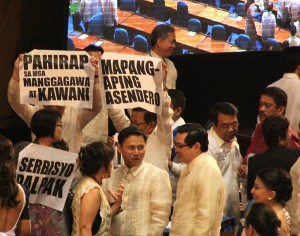
Placards raised by the Makabayan bloc after Aquino’s SONA. Photo by Boy Bagwis
In fact, something highly offensive did happen. But it wasn’t the display of placards—which the more discerning even laud as proof that democracy is alive in this country. What I found offensive, as a citizen and as a journalist, was the speech itself.
To begin with, it was the president’s last one, and yet he opened with a tirade that harks back to his very first. It was as if he—and his speechwriters—were totally impervious to the fact that he has gained the moniker “Boy Sisi” precisely because people do not appreciate being told what they already know (that the previous administration sucked) while not being shown what they haven’t really seen (why this administration is any better).
While it is already expected that the SONA, as usual, will be a showcase of what the president has claimed to have done rather than a soberly assessment of the real state of the nation, the sheer amount of self-serving platitudes, the obvious inaccuracies, the glaring omissions, the improbable generalities, and the attempt to cover it all up with the gloss of AVPs (audio-visual productions), gratefulness to his yaya and (gasp!) hairstylist, plus millenial wannabe quips just feels so…offensive. Bastos. An insult to millions of impoverished Filipinos, yayas and hairstylists included, who are found everywhere outside the Halls of Congress.
Imagine, for a moment, if Aquino had said these words at the crowded waiting room of the East Avenue Medical Center or the Philippine General Hospital: “Kung kabilang ang pamilya mo sa lowest quintile o ang pinakamahirap na 20 porsiyento ng ating populasyon, at nagpagamot ka sa pampublikong ospital, sigurado, wala kang kailangang bayaran.” The patients would have raised their hospital bills in protest–would the Presidential Security Guard have taken them all down?
Or, if the president had announced this at the public high school a stone’s throw away from Batasan Pambansa: “Ang suma-total ng naipagawa nating mga classroom at na-hire na guro ay higit pa sa pinagsama-samang nagawa mula sa nakalipas na 20 taon bago tayo manungkulan.” Using his own words, Edi wow. Would overworked teachers and students used to being crammed in dilapidated classrooms have hooted, “You’re the best president in two decades!”? Or would they have looked around and wondered, “What the hell did we miss?”
Reports and analysis from the media, NGOs, and people’s organizations have already refuted many of the more fantastic and bothersome claims made during the SONA, using both government and independent data.
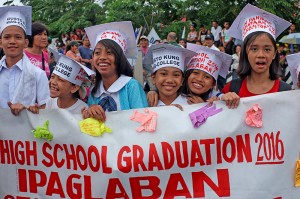
At the “People’s SONA” protest, students are opposed to the K-12. Photo by JL Burgos
One of the more controversial was the AVP featuring a supposed K-12 graduate, when everybody knows that the first batch of graduates will only be produced in about two years. Pressed for answers, the Palace admitted the mistake, and clarified that the student was a product of an experimental batch given a training by TESDA. The “mistake” illustrates the desperation of Aquino to claim success for what are all just air castles at this point. It also shows the folly of using video advertisements to sell a government program: it does not tell the whole picture; it actually directs attention away from it. I mean, conversing with my aunts and uncles whose children are entering senior high school tell me more about K-12 than anything in the SONA. However, the AVP did contain an ounce of truth (such is the double-sided nature of government propaganda). The fact remains that the featured student was unable to go to college. So do we really want an educational system that encourages that? And isn’t it rather obvious that our top officials, whose own children probably go to top universities abroad, are avoiding the question?
There were many other offensive utterances. For instance, if I were a non-regular worker (one in every three Filipino workers are, excluding agency-hired contractuals), I’d be offended by the statement, “Permanenteng trabaho ang nalikha natin.” And if I were a striking worker (like contractuals in Lucio Tan’s Tanduay Distillers, now on the second month of their strike), I’d be doubly offended by the president gloating to big business about how this country lacks workers who dare complain about low wages and inhumane working conditions (remember the Kentex tragedy?). We do not, by the way. What we lack are unions—only 8.6% of the labor force are unionized, precisely because of labor policies designed to crush unions and keep labor cheap and expendable.
If I were an OFW, I’d be offended by the claim that fewer Filipinos are leaving the country for better opportunities abroad. Government data furnished by a migrant group shows that in 2009, there were 2,500 OFWs who left the country daily. In 2015, that has increased to 6,092. I’d be offended that the only livelihood I’d be offered back home, if I am forced to flee, say, war or an abusive employer abroad, is “hilot wellness,” and that the government seems mighty proud of that.
If I were owner of a sari-sari store, I’d be offended that the president dare claim that we make the same amount of money and that I even have it easier because I probably have a stress-free life. To hear this while counting pennies and worrying about my children’s baon, I’d be really, really offended.
If I were a newly hired worker, I’d be offended by the jibe that I can now afford to acquire a new car and a condo unit, because back then, he couldn’t. He, the son of a former Philippine president and from the biggest landlord families in the country, who bought a Porsche early into his term, who reportedly gallivanted in a white Mercedes Benz the night he survived a coup attempt against his mother, would have us believe that there was a time in his life when he actually worried about a 20-year amortization for a second-hand car.
Is “Mapang-Aping Asendero,” held up by Anakpawis Rep. Fernando Hicap, an offensive placard? Probably, for the many landlords in the plenary. But for millions of farmers—nine out of 10 of whom remain landless—what may be more offensive is the zero mention of land reform. Even while land reform has never been genuinely implemented, past presidents at least paid lip service to it. I guess this time, Aquino had absolutely nothing to say. Is it because the mere mention of “land reform” would raise questions about Hacienda Luisita, and the hefty amount of taxpayers’ money that went to compensating their family for it even as it remains very much in their hands?
There is one thing Aquino did pay lip service to: peace in Mindanao. He equated it to the Bangsamoro Basic Law. But after a couple of sentences that were basically warnings to those who opposed it, we were back to AVP pseudo-reality, and none of the concerns about the law—especially on the distribution of land, resources, and political power—were addressed. No wonder that so many Mindanaoans felt let down, once again left out of the national narrative. The aspirations of the Moro people reduced to an empty promise of peace and progress, without addressing the root causes of insurgency, or even, of the long blackouts they have suffered these past few years.
Come to think of it, the word “insurgency” itself was never mentioned, and was instead equated to criminality. The status of the communist insurgency and the progress of the peace talks with the National Democratic Front (NDF) had always been SONA staples. This year, though, Aquino put the prominent NDF leaders Benito and Wilma Tiamzon in the same powerpoint slide as the leader of the Martilyo Gang, and, god forbid, general Jovito Palparan. Firstly, Palparan is not in jail. He is in the company of his own men inside military premises. It’s like putting the Tiamzons under the custody of the NPA and calling it detention. Secondly, lumping together such a disparate group as simple “criminals” is either supremely idiotic, or a calculated move to deny any shred of legitimacy to the decades-old insurgency, or even to the peace process that both sides have worked hard on. If I were a rebel, I’d be mighty offended. (Though they’re probably beyond that, and would rather focus their energies on the revolutionary cause, especially as Aquino has refused to talk peace.)
If I loathed corruption—like how Jim Paredes and the Liberal Party’s other civil society minions claim they are—I’d be offended that Aquino could still mouth his campaign catchphrase “kung walang corrupt, walang mahirap” and in his next sentence give praise to cabinet secretaries neck-deep in anomaly, such as Dinky Soliman (CCT and funds for Typhoon Yolanda victims), Jun Abaya and Mar Roxas (MRT-3), and Butch Abad (pork barrel scam). And, oh yes, Drilon (Iloilo Convention Center), the loudest boo-er of all. I’d be offended that the president, in front of the whole nation, asked lawmakers to pass a budget that included pork barrel in even larger lump sums and in more insidious forms, such as the Grassroots Participatory Budget placed suspiciously under the control of the newly proclaimed LP presidentiable.
Even if I was none of the above and just a journalist, still it is quite offensive that he mentioned the Ampatuan massacre only as a means to further denigrate his predecessor, and not in terms of justice to the victims. Fact is, witnesses were murdered one after the other in his term. Impunity thrives. To quote a former MILF fighter in one of the AVPs, “Parang hayop lang ang tingin nila sa amin. Pinagmamasaker, pinagpapatay nang walang kalaban-laban.” He was describing military atrocities under martial law, but he might as well have been describing the 262 extrajudicial killings for the past five years.
I am not one of the supposedly eight out of 10 Filipinos who, I quote, “naniniwalang developed o magiging developed country tayo sa hinaharap.” I am in fact pondering on the believability of a survey question that refers to both the present and the future. I for one would be hard put to answer the question “Are you happy or do you believe you can be happy in 10 years?” Turns out, in the said SWS survey commissioned by Sun Life Canada, there were two separate questions, and only three out of 10 Filipinos believed that we are already a developed country; the same number also believed that we can become one in 10 years. That is not the majority that Aquino would have us believe, and is actually only a measure of the world-renowned Filipino optimism, which may or may not have anything to do with his ‘Daang Matuwid’. Meanwhile, a survey by Ibon Foundation says that seven out of 10 Filipinos believe themselves to be poor–now that is something urgent, something real, something indicative of governance.
I can honestly go on and on, but unlike the president, I do not believe that rambling is effective. What I’d just like to point out is that if people watching or listening to the SONA on radio or TV got the feeling that Aquino was not really addressing them, then that feeling is tenfold from the gallery. Surrounded by probably the top 0.001% of Philippine society and their underlings (like my seatmate, a congressman’s staff who ogled female celebrities and expressed such delight with breadcrumbs thrown our away, such a month’s toll-free use of the Ayala-operated Manila-Cavite Expressway), the SONA felt solely addressed to them.
The truth is, the SONA is not, and has never been for the people. If it were, it would be held in a public place where ordinary folk, even those clad in slippers or wearing tatters, could listen and react freely, and perhaps even propose laws and policies that they wish for. As it is, the SONA is an exercise where the president addresses fellow members of the elite, who can never be insulted with lies or offended with fantasies, since they rule but do not live in the real world. For a moment, I almost pitied them—until they started boo-ing loudly, and I am reminded of how vulgar and vengeful they can actually be.

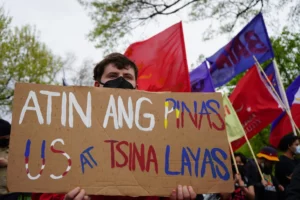
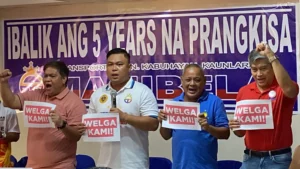
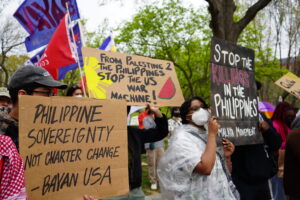
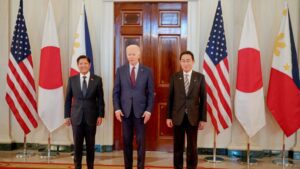
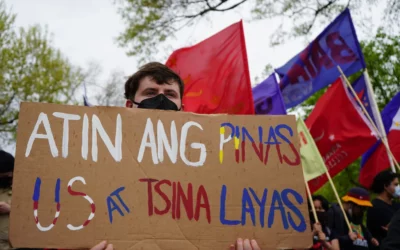
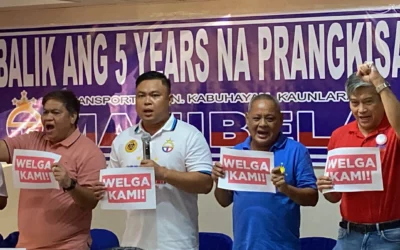
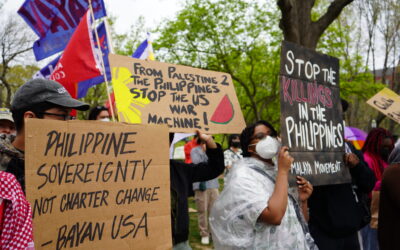
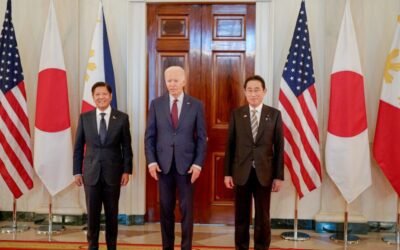
0 Comments